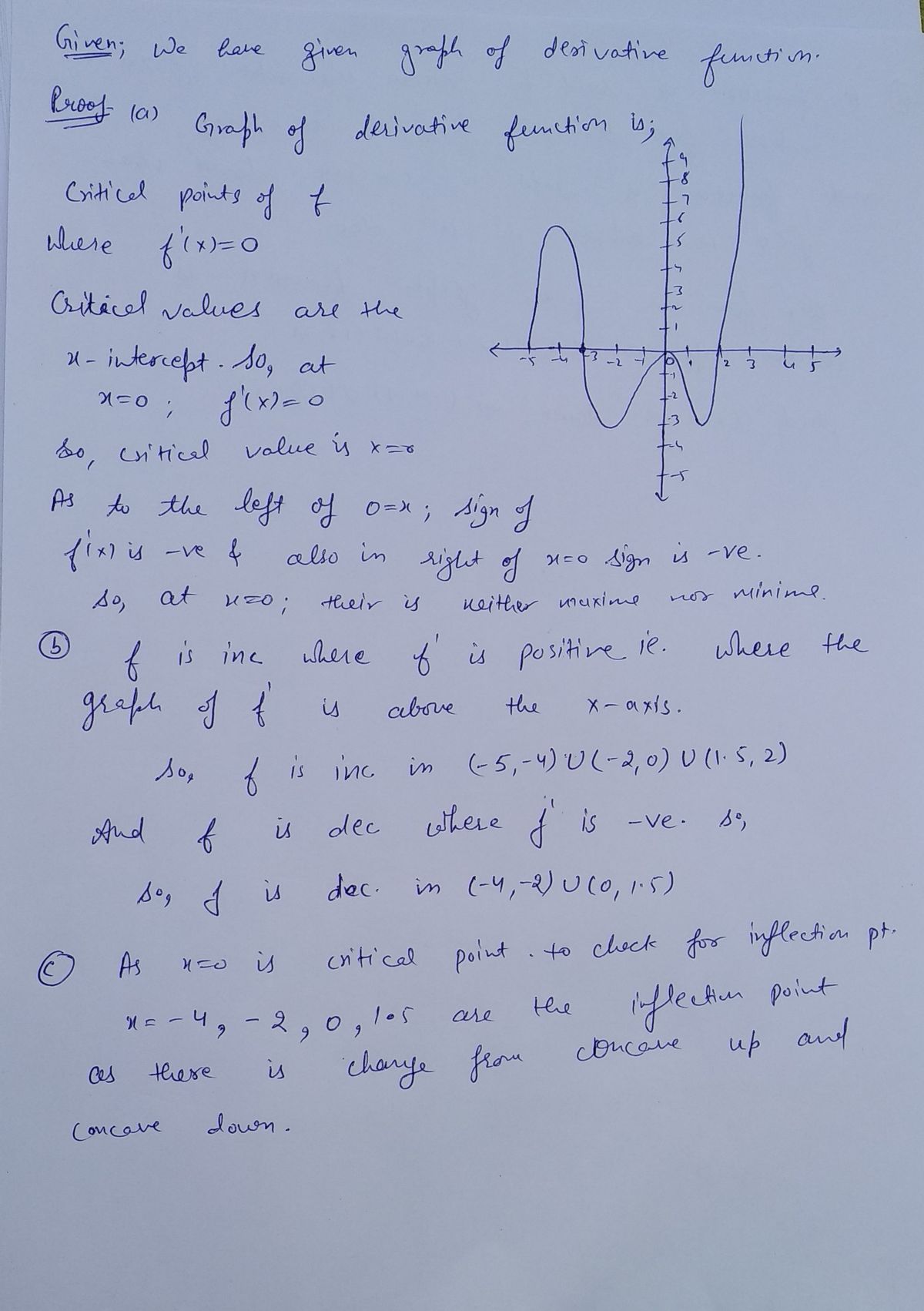The graph of derivative function y = f'(x) is given as föllóws. Answer the questions regarding the original function f (x). 10 (Careful: This is the graph of the derivative!) a) Find the x-coordinates of all critical points of the original function f(x), and determine their nature (local maximum, local minimum, or neither). b) Determine the intervals of increase and decrease for the original function f(x). c) Find the x-coordinates of all inflection points. d) Determine the intervals of concavity for the original function f (x).
The graph of derivative function y = f'(x) is given as föllóws. Answer the questions regarding the original function f (x). 10 (Careful: This is the graph of the derivative!) a) Find the x-coordinates of all critical points of the original function f(x), and determine their nature (local maximum, local minimum, or neither). b) Determine the intervals of increase and decrease for the original function f(x). c) Find the x-coordinates of all inflection points. d) Determine the intervals of concavity for the original function f (x).
Calculus: Early Transcendentals
8th Edition
ISBN:9781285741550
Author:James Stewart
Publisher:James Stewart
Chapter1: Functions And Models
Section: Chapter Questions
Problem 1RCC: (a) What is a function? What are its domain and range? (b) What is the graph of a function? (c) How...
Related questions
Question
100%

Transcribed Image Text:**Graph Analysis:**
This is a graph of the derivative function \( y = f'(x) \). The graph is a curve plotted on a coordinate plane with \( x \)-axis marked from approximately \(-10\) to \(10\) and \( y \)-axis from \(-10\) to \(10\). The curve intersects the \( x \)-axis at various points, creating distinct sections of positive and negative values.
---
**Text for Educational Website:**
The graph of the derivative function \( y = f'(x) \) is given as follows. Answer the questions regarding the original function \( f(x) \).
*(Careful: This is the graph of the derivative!)*
a) Find the \( x \)-coordinates of all critical points of the original function \( f(x) \), and determine their nature (local maximum, local minimum, or neither).
b) Determine the intervals of increase and decrease for the original function \( f(x) \).
c) Find the \( x \)-coordinates of all inflection points.
d) Determine the intervals of concavity for the original function \( f(x) \).
---
Analyzing the graph, you can locate:
- Critical points where \( f'(x) = 0 \) (intersections with the \( x \)-axis).
- Intervals of increase and decrease based on the sign of \( f'(x) \).
- Inflection points where \( f'(x) \) changes its trend from increasing to decreasing, or vice versa.
- Intervals of concavity identified by the behavior of \( f'(x) \).
Expert Solution
Step 1

Step by step
Solved in 2 steps with 2 images

Recommended textbooks for you

Calculus: Early Transcendentals
Calculus
ISBN:
9781285741550
Author:
James Stewart
Publisher:
Cengage Learning

Thomas' Calculus (14th Edition)
Calculus
ISBN:
9780134438986
Author:
Joel R. Hass, Christopher E. Heil, Maurice D. Weir
Publisher:
PEARSON

Calculus: Early Transcendentals (3rd Edition)
Calculus
ISBN:
9780134763644
Author:
William L. Briggs, Lyle Cochran, Bernard Gillett, Eric Schulz
Publisher:
PEARSON

Calculus: Early Transcendentals
Calculus
ISBN:
9781285741550
Author:
James Stewart
Publisher:
Cengage Learning

Thomas' Calculus (14th Edition)
Calculus
ISBN:
9780134438986
Author:
Joel R. Hass, Christopher E. Heil, Maurice D. Weir
Publisher:
PEARSON

Calculus: Early Transcendentals (3rd Edition)
Calculus
ISBN:
9780134763644
Author:
William L. Briggs, Lyle Cochran, Bernard Gillett, Eric Schulz
Publisher:
PEARSON

Calculus: Early Transcendentals
Calculus
ISBN:
9781319050740
Author:
Jon Rogawski, Colin Adams, Robert Franzosa
Publisher:
W. H. Freeman


Calculus: Early Transcendental Functions
Calculus
ISBN:
9781337552516
Author:
Ron Larson, Bruce H. Edwards
Publisher:
Cengage Learning